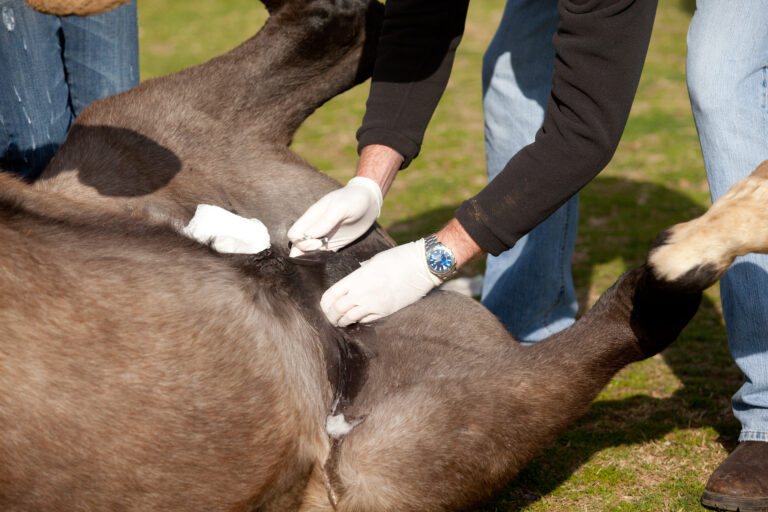
Abortion and stillbirth due to toxicant exposure is uncommon in horses in North America, although incidence in other geographic regions can vary. Toxicant-induced abortions can be due to a compound’s effects on the placenta, on the fetus, on the mare or any combination thereof. Any toxicant that produces significant clinical disease and stress in a pregnant mare could potentially lead to abortion as a sequela. Very few toxicants cause primarily or exclusively abortions with few or no signs observed in the mare. In North America, two of the best-characterized toxicologic causes of abortion in horses are ergopeptine alkaloids and swainsonine.
Ergopeptine Alkaloids
Ergopeptine alkaloids are most familiar to those in the Southeastern United States in association with tall fescue grass. Certain strains of tall fescue (e.g., Kentucky-31) are infected with the ergopeptine-producing fungal endophyte Neotyphodium coenophialum. Endophytes live within the plant, between its cells and are not visible to the naked eye. N. coenophialum primarily produces ergovaline and its epimer ergovalinine; it produces other ergopeptine alkaloids in much smaller quantities. N. coenophialum can also infect and produce similar ergopeptine alkaloid profiles within perennial ryegrass (Lolium perenne).
Ergot Fungus
Ergot fungus, Claviceps purpurea, infects the seed heads of a wide variety of grasses and small-grain forages. Most grasses can be affected, as can oats, wheat, barley and many other plants. “Ergotized” seed heads develop sclerotia—clusters of dark brown or black cylindrical fungal seeds or grains. Ergot fungus produces several different ergopeptine alkaloids, including ergocryptine, ergocornine, ergocristine and ergosine, often known collectively as ergot alkaloids. Ergopeptine alkaloids can exert a wide variety of effects in animals that ingest them, depending on animal species, reproductive status, dosage and time of year. Reproductive effects can include increased rates of embryonic death, prolonged luteal function and failure of normal udder development and lactation.
Effects in Late-Term Mares
The most severe and dramatic effects occur in late-term pregnant mares—abortion, premature placental separation (“red bag”), overmature/dysmature foals and potentially catastrophic dystocia that can result in death of the mare as well as the foal. Ergopeptine alkaloids act via several different mechanisms, some of which affect the fetus, some the mare and others the placenta. Endocrine disruption occurs in both the mare and the fetus.
In the mare, the alkaloids bind to dopamine receptors, causing a decrease in circulating prolactin. In the fetus, they inhibit adrenocorticotropic hormone (ACTH) secretion. Placental insufficiency and edema result from the vasoconstrictive effects of the alkaloids. Placental fibrosis and mucoid degeneration of arteries can also result.
Swainsonine
Fungal endophytes also produce swainsonine. In North America, several species of Astragalus and Oxytropis, known as locoweeds, are the most significant hosts of swainsonine-producing endophytes. Locoweeds are found primarily in rangelands in the Western United States. Slafractonia leguminicola (Rhizoctonia leguminicola), the fungus that causes “black patch” disease of red clover and other legumes, also produces swainsonine. In other geographical regions, plants containing swainsonine include Swainsona canescens, a legume native to Australia; Turbina cordata and several Ipomoea species in South America and Australia; I. carnea, found throughout the tropics worldwide; and Sida carpinifolia in Brazil. Swainsonine affects cellular metabolism by inhibiting mannosidases, causing accumulation of incompletely metabolized oligosaccharides and glycoproteins, cytoplasmic vacuolation and eventually vacuolar degeneration in multiple organs.
Most animal species are affected, although horses appear to be the most sensitive. Classic signs of swainsonine toxicosis in horses include aberrant behavior and other neurologic abnormalities. However, in pregnant mares, swainsonine can cause embryonic or fetal death and abortion.
Anemia and Methemoglobinemia
Any disease process causing anemia and/or methemoglobinemia in pregnant mares can result in fetal hypoxia and death. Potential toxic agents include anticoagulant rodenticides and compounds that cause oxidative red blood cell damage. Brodifacoum toxicosis was reported to have caused abortion in a pregnant Arabian mare. Although the mare survived with hospitalization and aggressive treatment, she aborted the fetus. Red maple (Acer rubrum) toxicosis was suspected to have caused abortions in Percheron mares, but confirmatory testing was not performed. The mares were critically ill and ultimately died, but necropsy was not performed to definitively determine cause of death or abortion. Any disease process causing anemia and/or methemoglobinemia in pregnant mares can result in fetal hypoxia and death. Potential toxic agents include anticoagulant rodenticides and compounds that cause oxidative red blood cell damage.
Other toxicants that can cause methemoglobinemia and hemolytic anemia include red maple hybrids, silver maple and sugar maple; Pistacia species; Allium species (e.g., garlic, chives, and others); propylene glycol; and phenothiazines. Several therapeutic medications can cause abortions, including prostaglandin (often used for the purpose), oxytocin and glucocorticoids. Finally, any toxicant that causes significant systemic disease and stress to a pregnant mare has the potential to induce abortion. Examples include ionophores, cantharidin, antibiotic-associated colitis, and many others.
Diagnosis of Toxicologic Causes of Abortion in Horses
Diagnosis of toxicologic causes of abortion relies on a history of exposure to significant quantities of a toxicant and ruling out other, more common, causes of abortion in horses. Confirmatory testing is rarely possible due to a lack of analytical methods and lack of established clinically significant concentrations of a toxicant. In other cases, the time elapsed between exposure and abortion might preclude detection of a toxicant in blood or tissues. In cases of suspected toxicologic causes of abortion, veterinarians should perform a complete necropsy including microscopic evaluation of fetal and placental tissues. A thorough history including any possible exposures should be provided to the pathologist to direct potential ancillary testing, including consultation with a toxicologist.
This article originally appeared in the January 2023 issue of Equine Disease Quarterly.







